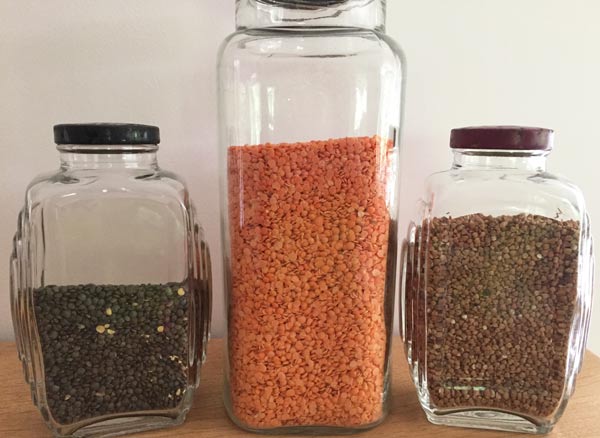|
|
Dealing with less common legume allergiesSarah Leggatt is a freelance health writer. Her son has allergies to multiple foods, including pea, lentil and chickpea.
Image courtesy of Sue Cane Legumes are a common cause of allergic reactions. Peanut is perhaps the most well-known, but many others — such as peas, beans, lentils and even some spices — may also cause problems. These legumes are widely used in our foods, yet fall outside EU food allergy labelling laws. People dealing with these allergies face many challenges, when it comes to staying safe. Under EU law, 14 allergens must be highlighted on the ingredient lists of pre-packed foods. These are: celery, cereals containing gluten, crustaceans, eggs, fish, lupin, milk, molluscs, mustard, nuts, peanuts, sesame, soya and sulphur dioxide / sulphites. Catering outlets must also hold information on the 14 allergens for meals prepared in restaurants, or for foods packed and sold on the premises. Only three legumes are among the 14 allergens: peanut, soya and lupin. Other legumes are not protected by these labelling laws. What are legumes? Legumes are edible seeds, enclosed in pods. The dried seeds are known as pulses. Legumes are a broad group of plant foods, which includes non-top-14 legumes such as:
How common are legume allergies? While the prevalence of non-top-14 legume allergy in the UK is unknown, the Anaphylaxis Campaign takes regular calls to its helpline about specific legumes. Lentils, peas and chickpeas are most likely to trigger reactions. The charity’s 2019 figures show the number of members avoiding non-top-14 legumes as follows: lentils (24), peas (19), chickpeas (17), kidney beans (1) and other beans (12). These figures only provide a snapshot of the UK charity’s current members, rather than any wider prevalence data. But it’s interesting to see how they compare with the top-14 allergens. While the number of members avoiding peanut (1870) or soya (101) is far higher, nearly as many members avoid lentils (24) as they do top-14 legume lupin (26). And more members report separate allergies to lentils, peas and chickpeas than to top-14 allergens celery (14) and sulphites (5). These figures reflect the position in the UK rather than the wider EU. In the UK, the Asian community is thought to be at particular risk from these type of legume allergies, as chickpeas, lentils and fenugreek are widely used in Indian cooking. Symptoms and diagnosis Milder reactions may cause vomiting, skin rash, itching and hives. But more severe reactions may trigger anaphylaxis. Symptoms include wheezing, difficulty breathing, throat swelling and collapse. This needs emergency medical treatment and prompt administration of adrenaline. As there is a degree of cross-reactivity between legumes — meaning the proteins in one may be similar to the proteins in another — many people will react to more than one legume. But most will not need to avoid all legumes. Many people with peanut or soya allergy are able to eat other legumes without any problems. But some will also react to lentil and/or pea, for example. Others may test positive to non-top-14 legumes but not have symptoms eating them. It’s a complex area, so it’s important to have a proper history and diagnosis from an allergist. Skin prick and blood tests may help to clarify the extent of any allergies. Avoiding legumes Avoiding legumes outside the top 14 is not easy. Aside from the labelling issues, legumes are increasingly used in our foods. As plant-based eating becomes more common, so too have vegan products and restaurant dishes containing legumes outside the top 14. Legumes also crop up in many free-from and gluten-free products, and often in places that you wouldn’t expect. Peas and beans, for example, are widely used to replace egg and gluten in free-from and gluten-free bakery items. This creates a real problem for legume-allergic consumers. Many may also have allergies within the top 14 and be regular buyers from the free-from aisle. Using legumes in food seems to be part of a growing trend. Dr. Hazel Gowland, expert in allergy risks, says: ‘Adding pea and bean flour to bread and other products is becoming more widespread, as food technologists are looking for new and cheaper protein sources to replace the 14 allergens.’ Even outside the free-from section, peas and beans are now found in many everyday items, like sausages and burgers. If you are dealing with these allergies, how can you stay safe? Common problem foods Foods to watch out for include:
Reading food labels All legumes should be named in the full list of ingredients on pre-packed foods. However, you still need to be careful.
Eating out Eating out can be a minefield for anyone with food allergies, and even more so for those with allergies outside the top 14. But with some advance planning it can be done. The larger chains are often a good option for eating out. They are more likely to have standardised menus and ingredients, streamlined processes and staff allergy training. Restaurant online allergen information rarely covers allergens beyond the top 14. But some catering outlets do go the extra mile and give a full list of ingredients online or in their allergy folders.
Remember that anyone else who cooks for you or your child — family, friends and school — also needs to know about labelling and cross-contamination. With the rise in vegan and free-from products, the use of legumes in our foods looks set to increase. Anyone dealing with allergies to legumes outside the top 14 faces many challenges. By taking extra care when shopping and eating out, it is possible to navigate any problems and stay safe. March 2019 NB Information on this site is not a substitute for medical advice and no liability can be assumed for its use. |













